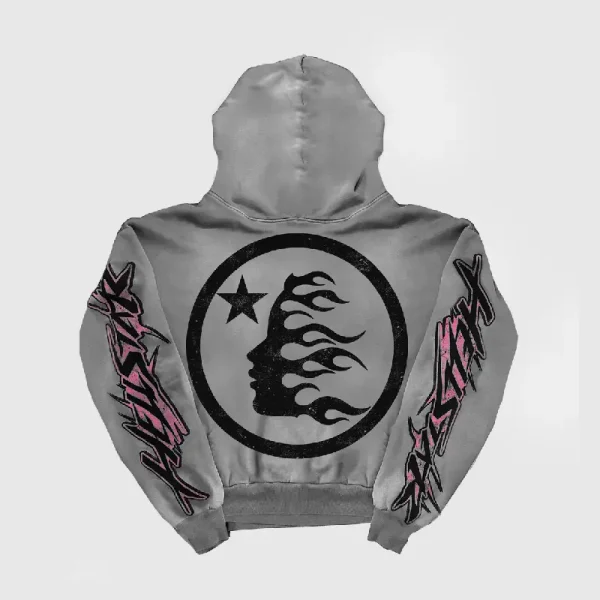Hellstar Clothing: The Underground Label That Took Over Mainstream Fashion
In a fashion world driven by corporate labels, algorithm-fed trends, and influencer deals, Hellstar Clothing emerged like a bolt of lightning—a raw, unapologetic brand that spoke directly to the streets. It didn’t follow traditional fashion rules, didn’t chase mass appeal, and didn’t need a big-budget marketing campaign to grab attention. What started in the underground quickly caught fire, and before anyone could predict it, Hellstar became one of the most sought-after names in contemporary streetwear.
So how did a small, mysterious label with roots in underground fashion culture rise to dominate the mainstream? Let’s break down the rise of Hellstar Clothing, the brand that turned rebellion into fashion gold.
1. Built in the Shadows, Made for the Spotlight
Hellstar was never meant to be a commercial brand. Its founders envisioned it as a creative expression of duality—light vs. darkness, heaven vs. hell, spirit vs. street. With a name that itself embodies contradiction, “Hellstar” became a platform for deep themes like rebirth, spiritual struggle, and existential resistance.
These weren’t just hoodies and tees—they were visual statements, often carrying messages like “Heaven Can’t Save You” or “Born Again.” The brand resonated with a new generation that didn’t want fashion filtered through boardroom sensibilities. Hellstar gave them raw truth, emotion, and attitude.
2. Spiritual Symbolism Meets Gritty Streetwear
One of Hellstar’s defining characteristics is its use of religious and cosmic iconography. Crosses, flames, angelic beings, astrological signs, and scriptural references often appear in their designs. But rather than preaching, Hellstar uses these visuals to explore identity and inner conflict.
This spiritual aesthetic was unusual in streetwear at the time. Most brands were focused on bright logos, pop culture references, or luxury minimalism. Hellstar went the opposite route: dark, philosophical, and often uncomfortable. That’s precisely what made it magnetic.
3. Street-Level Authenticity
Hellstar never tried to be polished or mass-market. Its drops were often limited, the messaging cryptic, and the branding raw. You couldn’t find it in big-box retailers or through glossy ad campaigns. Instead, you found it on:
-
Underground rappers
-
Skate crews
-
Independent creatives
-
Instagram moodboards
The label lived and breathed underground culture, which gave it instant credibility. While many brands try to look like they came from the streets, Hellstar actually did.
4. Hype Built on Scarcity and Energy
Scarcity has always fueled streetwear, and Hellstar used this to its advantage. Their limited drops created urgency. Pieces would sell out in minutes. Resale values would spike overnight. But more importantly, each drop was unpredictable—adding to the mystique.
There were no scheduled release calendars or mainstream fashion week debuts. Fans had to stay alert, follow the brand’s social media, and engage with the Hellstar community. That sense of exclusivity kept hype alive and turned every release into an online event.
5. Co-Signs That Felt Organic
Rather than throwing money at influencers, Hellstar let the culture come to it. Soon, the brand was spotted on key underground figures and rap artists—often without any official partnership.
When fans saw rappers, stylists, and underground icons wearing Hellstar organically, it gave the brand even more credibility. The co-signs were earned, not bought, which made them matter more.
As its reach grew, so did the interest from celebrities outside the underground. From New York to London to Tokyo, Hellstar’s flame kept spreading, pulled by cultural momentum—not corporate marketing.
6. Breaking into the Mainstream—Without Selling Out
Hellstar’s biggest success is perhaps its ability to become mainstream without diluting its identity. That’s rare in fashion. Often, underground brands lose their edge once they enter commercial territory. Hellstar didn’t.
Despite increased popularity, the label retained:
-
Its moody, edgy aesthetic
-
Cryptic messaging and spiritual overtones
-
Limited availability and high demand
It may now be featured in fashion blogs and worn by global icons, but Hellstar has stayed loyal to the core community that built it.
7. A Global Cultural Shift
Part of Hellstar’s rise comes from a broader cultural shift. Gen Z and Millennial fashion lovers are moving beyond logo-based clothing and fast fashion. They’re seeking meaning, emotion, and connection in what they wear.
Hellstar taps into those needs. The brand speaks to people going through real things—growth, chaos, transformation, identity. It offers a way to wear those emotions on your sleeve—literally.
As this movement gains momentum globally, brands like Hellstar are thriving, not because they follow trends—but because they define them.
8. More Than a Brand—A Movement
At its heart, Hellstar Clothing is more than just a streetwear label. It’s a movement, a philosophy wrapped in heavy cotton and bold ink. It challenges the idea that fashion has to be clean, corporate, or comforting. It invites its wearers to embrace darkness, question norms, and find beauty in conflict.
The brand’s fans don’t just wear Hellstar—they live it. They’re drawn to its attitude, its deeper meanings, and its rejection of surface-level fashion.
Conclusion: From the Shadows to the Spotlight
Hellstar Clothing’s journey from underground label to mainstream fashion force proves that authenticity still matters. By staying true to its roots, https://hellstarclothings.shop/ embracing spiritual rebellion, and refusing to compromise on identity, Hellstar has risen above the noise.
In 2025 and beyond, Hellstar isn’t just part of the streetwear conversation—it’s shaping it. And whether you’re a longtime supporter or a newcomer just discovering its message, one thing is clear: Hellstar isn’t just a brand—it’s a statement.


